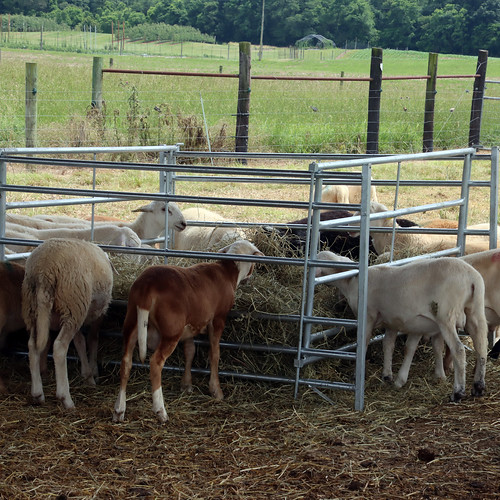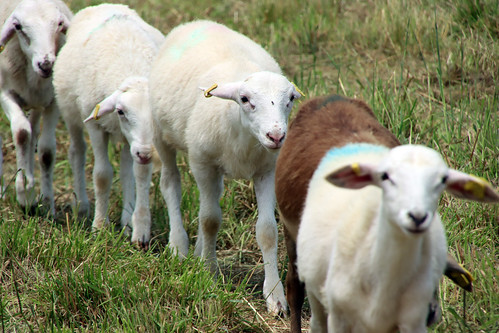
Small Ruminant Research @ WMREC
Saturday, July 3, 2021
Friday, July 2, 2021
Experiment Starts
On June 25, after being sorted for weight, age, birth type, and fecal egg count, the lambs were randomly allocated to two treatment groups: PASTURE and SUPPLEMENTED. They were re-weighed and scored to get starting data.
The PASTURE (n=50) group will be rotationally-grazed on 5 acres of mixed pasture. They will be moved to a new paddock every 7 days. Forage samples will be collected at the beginning of each grazing period. The SUPPLEMENTED (n=49) group will receive a daily supplement of energy (whole barlely). The goal is to feed them 1 lb. per head per day. So far, they have been slow to eat the barley. The supplemented lambs will similarly graze 5 acres of mixed pasture.
Starting weights range from 30.4 to 107 lbs. and average 62.4 ± 13.3 lbs. The median weight is 62.6 lbs. During the 10 day acclimation period, the lambs gained an average of 0.265 ± 0.236 lbs. per day. The median gain was 0.240 lbs. per day. Body condition scores ranged from 2.0 to 3.2 and averaged 2.6 ± 0.2. FAMACHA© scores ranged from 1 to 3 and averaged 2.2 ± 0.7. No lambs had positive dag scores or diarrhea (scours). Fecal samples were collected from each lamb on June 15. Fecal egg counts ranged from 0 to 1050 and averaged 112 ± 162 EPG (very low).
Group |
Number |
Birth type |
Age |
Weight |
BCS |
FAMACHA© |
FEC |
| Pasture | 50 | 2.2 | 88.5 | 62.8 | 2.7 | 2.1 | 99 |
| Suppl. | 49 | 2.3 | 87.3 | 62.0 | 2.6 | 2.2 | 126 |
| All | 99 | 2.3 | 87.9 | 62.4 | 2.6 | 2.2 | 112 |
Wednesday, June 23, 2021
Preliminary data
On June 15, the lambs ranged in weight from 26.4 to 102.4 lbs. and averaged 59.4 ± 13.4 lbs. The median weight was 60.4 lbs. Aged ranged from 78 to 108 days and averaged 87.7 ± 6.2 days. The median age was 87 days. The median birth date was March 20. FAMACHA© scores ranged from 1 to 3 and averaged 1.9 ± 0.7. Body condition scores ranged from 2.0 to 3.4 and averaged 2.7 ± 0.3. None of the lambs had positive dag scores. Birth type ranged from 1 (single) to 4 (quad) and averaged 2.3 ± 0.7.
During the acclimation period, the lambs have access to ~2.5 acres of silvopasture: mixed hardwoods and walnut trees. They also have access to orchardgrass hay. The central laneway provides access to water, shelter, hay, and free choice minerals. The lambs will be sorted into their two groups on June 25. The lambs will be randomly assigned to groups based on weight, age, birth type, and fecal egg count.
Monday, June 21, 2021
101 lambs arrive
One hundred and one Katahdin ram lambs were delivered to the Western Maryland Research & Education Center on June 15. The lambs were provided by Ewe Lamb Right Farm in Shippensburg, PA. They will be used in a pasture supplementation study, a repeat of the 2020 study with lambs from the same farm.
Friday, May 28, 2021
Thursday, October 22, 2020
Scanning data
Due to Covid, we were unable to process the lambs to collect actual carcass data. A sample could not be obtained for fatty acid analysis. Instead the lambs were scanned (with ultrasound) to determine carcass traits. Seveny-one lambs were scanned on October 2 by Melanie Barkley from Penn State University. Melanie is certified to scan for NSIP.
Back ranged from 1.98 to 7.55 mm and averaged 4.44 ± 1.20 mm. The median back fat was 4.39 mm. The SUPPLEMENTED lambs had more backfat than the PASTURE lambs: 4.77 ± 1.08 vs. 4.17 ± 1.24 mm. They also had greater loin depth: 23.5 ± 2.7 vs. 22.7 ± 2.5 mm.
Hair sheep are more difficult to scan than wooled lambs. The hair makes it difficult to make contact with the probe. Surgical blades are necessary to clip the hair for scanning.
-
Sixty-four lambs were used to compare the growth, carcass, and reproductive characteristics of intact ram (n=21), short-scrotum (SC) ram (n=...
-
Due to Covid, we were unable to process the lambs to collect actual carcass data. A sample could not be obtained for fatty acid analysis. In...










